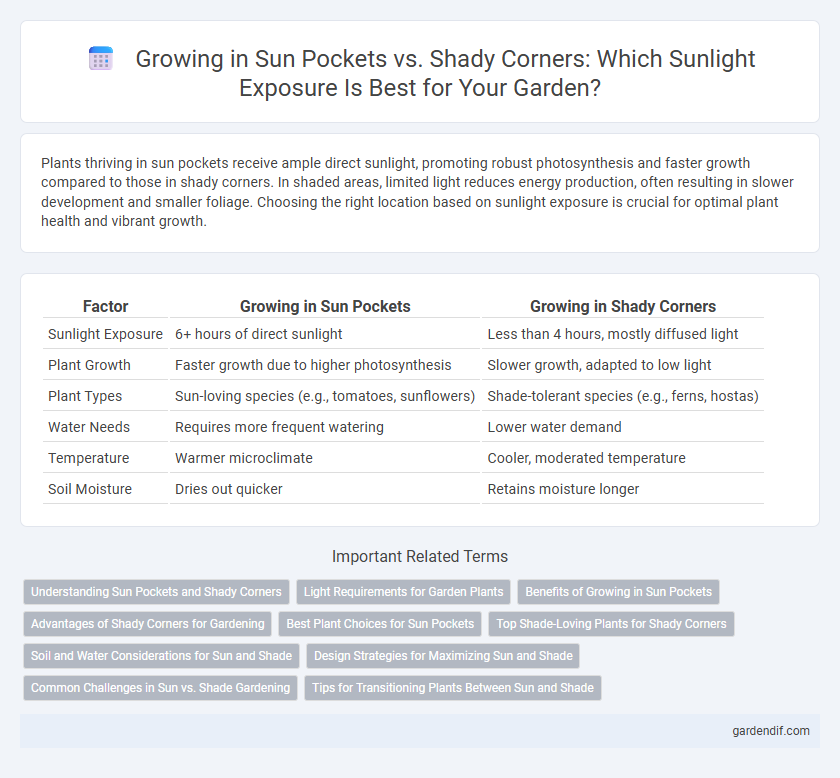
Growing in Sun Pockets vs Growing in Shady Corners Illustration
Plants thriving in sun pockets receive ample direct sunlight, promoting robust photosynthesis and faster growth compared to those in shady corners. In shaded areas, limited light reduces energy production, often resulting in slower development and smaller foliage. Choosing the right location based on sunlight exposure is crucial for optimal plant health and vibrant growth.
Table of Comparison
| Factor | Growing in Sun Pockets | Growing in Shady Corners |
|---|---|---|
| Sunlight Exposure | 6+ hours of direct sunlight | Less than 4 hours, mostly diffused light |
| Plant Growth | Faster growth due to higher photosynthesis | Slower growth, adapted to low light |
| Plant Types | Sun-loving species (e.g., tomatoes, sunflowers) | Shade-tolerant species (e.g., ferns, hostas) |
| Water Needs | Requires more frequent watering | Lower water demand |
| Temperature | Warmer microclimate | Cooler, moderated temperature |
| Soil Moisture | Dries out quicker | Retains moisture longer |
Understanding Sun Pockets and Shady Corners
Sun pockets are small areas where sunlight concentrates, offering ideal conditions for sun-loving plants to thrive with increased photosynthesis and growth rates. Shady corners, characterized by limited direct sunlight due to obstruction by walls, trees, or buildings, favor shade-tolerant species adapted to lower light intensity and slower development. Understanding the specific light availability in sun pockets versus shady corners is crucial for selecting appropriate plant varieties and optimizing garden productivity.
Light Requirements for Garden Plants
Garden plants growing in sun pockets thrive due to ample direct sunlight, which supports photosynthesis, promotes vigorous growth, and enhances flowering and fruit production. Plants in shady corners require species adapted to low light conditions, such as ferns and hostas, to optimize energy absorption despite limited sunlight. Understanding the specific light requirements of each plant ensures proper placement, maximizing growth potential and overall garden health.
Benefits of Growing in Sun Pockets
Growing plants in sun pockets boosts photosynthesis, leading to stronger growth and higher yields compared to shady corners. Sun pockets provide optimal light exposure, enhancing nutrient absorption and improving flowering and fruiting rates. This microenvironment minimizes fungal diseases by promoting faster leaf drying, making it ideal for sun-loving plants.
Advantages of Shady Corners for Gardening
Shady corners provide an ideal microclimate for plants that thrive in lower light, promoting stronger leaves and reducing water evaporation. These areas protect delicate roots from overheating, enhancing moisture retention and nutrient absorption. Growing in shaded environments also decreases the risk of sunburn on sensitive foliage, supporting healthier and more resilient garden growth.
Best Plant Choices for Sun Pockets
Sun pockets, characterized by concentrated, intense sunlight, are ideal for sun-loving plants like succulents, lavender, and rosemary that thrive with at least six hours of direct sun daily. These plants exhibit robust growth, vibrant foliage, and prolific flowering when exposed to such bright conditions, outperforming shade-tolerant species in these environments. Selecting herbaceous perennials and Mediterranean natives optimizes sun pocket gardens by maximizing photosynthesis and drought resistance.
Top Shade-Loving Plants for Shady Corners
Shade-loving plants such as hostas, ferns, and astilbes thrive in shady corners where sunlight is limited, making them ideal for growth in such microclimates. These plants adapt to low-light conditions by maximizing photosynthesis efficiency in diffuse light, unlike sun pocket plants that require direct sunlight for optimal growth. Selecting top shade-loving species can enhance garden aesthetics and biodiversity in areas with minimal sun exposure.
Soil and Water Considerations for Sun and Shade
Soil in sun pockets tends to dry out quickly, requiring well-draining, moisture-retentive substrates to support plant growth, while shady corners often have cooler, damper soil that may retain moisture longer but can also lead to root rot if drainage is poor. Plants in sunny areas typically need more frequent watering to compensate for increased evaporation, whereas shade-loving plants benefit from less frequent watering to prevent over-saturation. Optimizing soil composition with organic matter in both environments enhances water retention and aeration, ensuring healthy root development regardless of sun exposure.
Design Strategies for Maximizing Sun and Shade
Design strategies for maximizing sunlight include planting sun-loving species such as lavender, rosemary, and sunflowers in sun pockets where exposure ranges from six to eight hours daily. In shady corners, shade-tolerant plants like hostas, ferns, and astilbes thrive by adapting to limited light conditions, requiring soil amendments to retain moisture and enhance nutrient availability. Incorporating reflective surfaces and layered plantings optimizes light distribution, ensuring balanced growth across varying microclimates.
Common Challenges in Sun vs. Shade Gardening
Plants growing in sun pockets often face challenges such as excessive heat stress, soil moisture evaporation, and nutrient depletion caused by intense sunlight exposure. In contrast, plants in shady corners commonly struggle with inadequate light for photosynthesis, leading to slower growth and increased susceptibility to fungal diseases due to higher humidity. Both sun and shade gardening require tailored soil amendments and watering strategies to optimize plant health and productivity.
Tips for Transitioning Plants Between Sun and Shade
Gradually acclimate plants by increasing their exposure to sunlight by 1-2 hours daily over a week to prevent shock and leaf burn. Monitor soil moisture closely, as sun-exposed plants may require more frequent watering compared to shady locations. Use shade cloth or strategically position plants to filter intense midday sun during the transition to avoid stress and promote healthy growth.
Growing in Sun Pockets vs Growing in Shady Corners Infographic

 gardendif.com
gardendif.com